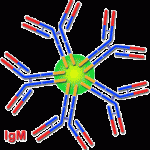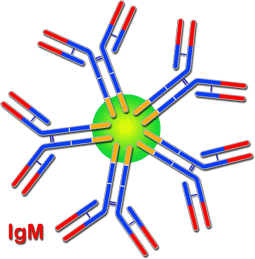What determines the outcome of acute hepatitis B?
The body’s immune response is the major determinant of the outcome in acute hepatitis B. Individuals who develop a strong immune response to the infection are more likely to clear the virus and recover. However, these patients also are more likely to develop more severe liver injury and symptoms due to the strong immune response that is trying to eliminate the virus. On the other hand, a weaker immune response results in less liver injury and fewer symptoms but a higher risk of developing chronic hepatitis B. People who recover and eliminate the virus will develop life-long immunity, that is, protection from subsequent infection from hepatitis B.
Most infants and children who acquire acute hepatitis B viral infection have no symptoms. In these individuals, the immune system fails to mount a vigorous response to the virus. Consequently, the risk of an infected infant developing chronic hepatitis B is greater than 95%. In contrast, only 5% of adults who have acute hepatitis B develop chronic hepatitis B.
How is hepatitis B diagnosed?
Infection with hepatitis B is suspected when the medical history and the physical examination reveal risk factors for the infection or symptoms and signs that are suggestive of hepatitis B. Abnormalities in the liver tests (blood tests) also can raise suspicion; however, abnormal liver tests can result from many conditions that affect the liver. The diagnosis of hepatitis B can be made only with specific hepatitis B virus blood tests. These tests are known as hepatitis ‘markers’ or ‘serology.’
 Markers found in the blood can confirm hepatitis B infection and differentiate acute from chronic infection. These markers are substances produced by the hepatitis B virus (antigens) and antibodies produced by the immune system to fight the virus. Hepatitis B virus has three antigens for which there are commonly-used tests – the surface antigen (HBsAg), the core antigen (HBcAg) and the e antigen (HBeAg).
Markers found in the blood can confirm hepatitis B infection and differentiate acute from chronic infection. These markers are substances produced by the hepatitis B virus (antigens) and antibodies produced by the immune system to fight the virus. Hepatitis B virus has three antigens for which there are commonly-used tests – the surface antigen (HBsAg), the core antigen (HBcAg) and the e antigen (HBeAg).
HBsAg and anti-HBs
The presence of hepatitis B surface antigen (HBsAg) in the blood indicates that the patient is currently infected with the virus. HBsAg appears an average of four weeks after initial exposure to the virus. Individuals who recover from acute hepatitis B infections clear the blood of HBsAg within approximately four months after the onset of symptoms. These individuals develop antibodies to HBsAg (anti-HBs). Anti-HBs provides complete immunity to subsequent hepatitis B viral infection. Similarly, individuals who are successfully vaccinated against hepatitis B produce anti-HBs in the blood.
Patients who fail to clear the virus during an acute episode develop chronic hepatitis B. The diagnosis of chronic hepatitis B is made when the HBsAg is present in the blood for at least six months. In chronic hepatitis B, HBsAg can be detected for many years, and anti-HBs does not appear.
Anti-HBc
 In acute hepatitis, a specific class of early antibodies (IgM) appears that is directed against the hepatitis B core antigen (anti-HBc IgM). Later, another class of antibody, anti-HBc IgG, develops and persists for life, regardless of whether the individual recovers or develops chronic infection. Only anti-HBc IgM can be used to diagnose an acute hepatitis B infection.
In acute hepatitis, a specific class of early antibodies (IgM) appears that is directed against the hepatitis B core antigen (anti-HBc IgM). Later, another class of antibody, anti-HBc IgG, develops and persists for life, regardless of whether the individual recovers or develops chronic infection. Only anti-HBc IgM can be used to diagnose an acute hepatitis B infection.
HBeAg, anti-HBe, and pre-core mutations
Hepatitis B e antigen (HBeAg) is present when the hepatitis B virus is actively multiplying, whereas the production of the antibody, anti-HBe, (also called HBeAg seroconversion) signifies a more inactive state of the virus and a lower risk of transmission.
In some individuals infected with hepatitis B virus, the genetic material for the virus has undergone a structural change, called a pre-core mutation. This mutation results in an inability of the hepatitis B virus to produce HBeAg, even though the virus is actively reproducing. This means that even though no HBeAg is detected in the blood of people with the mutation, the hepatitis B virus is still active in these persons and they can infect others.
Hepatitis B virus DNA
The best marker of hepatitis B virus reproduction is the level of hepatitis B virus DNA in the blood. Detection of hepatitis B virus DNA in a blood sample signals that the virus is actively multiplying. In acute hepatitis, HBV DNA is present soon after infection, but is eliminated over time in patients’ who clear the infection. In chronic hepatitis, levels of HBV DNA often continue to be elevated for many years and then decrease as the immune system controls the virus. HBV DNA levels are sometimes referred to as the ‘viral load’.
How are the hepatitis B blood tests interpreted?
 The following table gives the usual interpretation for sets of results from hepatitis B blood (serological) tests.
The following table gives the usual interpretation for sets of results from hepatitis B blood (serological) tests.
|
Most Likely Status* |
Tests |
Results |
| Susceptible, not infected, not immune | HBsAg anti-HBc anti-HBs |
negative negative negative |
| Immune due to natural infection | HBsAg anti-HBc anti-HBs |
negative positive positive |
| Immune do to hepatitis B vaccination | HBsAg anti-HBc anti-HBS |
negative negative positive |
| Acutely infected | HBsAg anti-HBc IgM anti-HBc anti-HBs |
positive positive positive negative |
| Chronically infected | HBsAg anti-HBc IgM anti-HBc anti-HBs |
positive positive negative negative |
*Interpretation of the hepatitis B virus blood tests should always be made by an experienced clinician with knowledge of the patient’s medical history, physical examination, and results of the standard liver blood tests.
